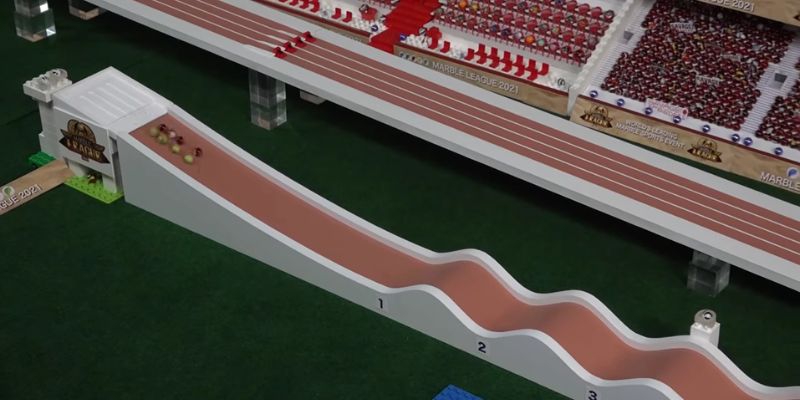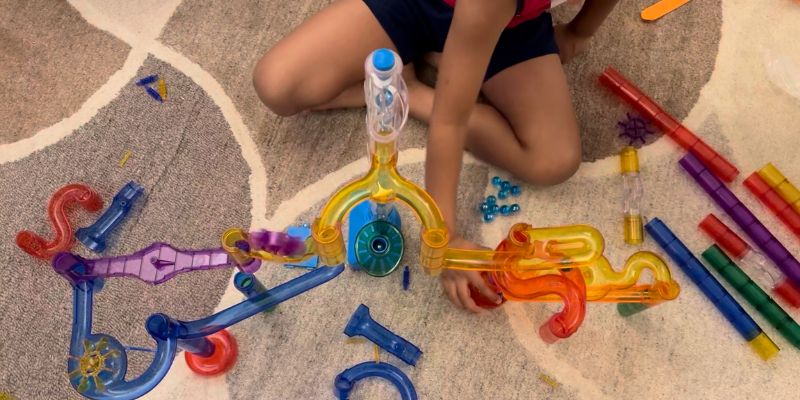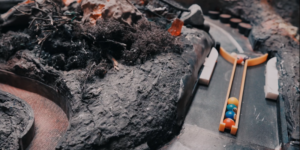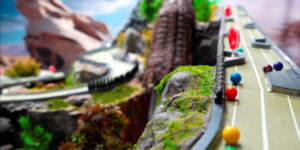Buckle up, marble racing fans, because we’re about to take a deep dive into one of the most thrilling elements of any track: the jump! These gravity-defying leaps add an extra layer of excitement and challenge to every race, testing the marbles’ speed, precision, and the builder’s ingenuity.
In this article, we’ll explore the different types of marble racing track jumps, delve into the physics that make them possible, and provide you with expert tips on designing and conquering these exhilarating obstacles. Get ready to elevate your marble racing game to new heights!
Why Jumps Are Essential to Marble Racing Tracks
Marble racing track jumps are the thrilling highlights that leave spectators gasping and racers strategizing. Beyond their visual spectacle, jumps significantly enhance the excitement, challenge, and skill involved in marble racing.

The Thrill Factor: Injecting Excitement and Unpredictability
Jumps add a dynamic element of suspense and unpredictability to marble races. Watching a marble soar over a gap, the anticipation of whether it will land perfectly or tumble dramatically adds to the excitement. This element of uncertainty keeps viewers on the edge of their seats, creating a heart-pounding spectacle.
Skill Showcase: A Test of Precision and Timing
Successfully navigating jumps requires a high level of skill and precision. Racers must carefully calculate the marble’s speed and trajectory to ensure it clears the gap without overshooting the landing zone. A successful jump is a testament to a racer’s understanding of physics and their ability to control the marble’s movement.
Strategic Maneuvers: Gaining an Edge over the Competition
Jumps are strategic tools that can provide a competitive advantage. A well-timed jump can allow a marble to overtake an opponent, while a poorly executed one can result in a loss of momentum. Mastering the art of jumping enables racers to use it strategically, positioning themselves for victory.
Enhancing Track Variety and Challenge
Incorporating jumps into various sections of the track adds variety and breaks up the monotony of straightaways and curves. Jumps create a diverse and challenging course that tests the marbles’ versatility and adaptability, enhancing the overall racing experience.
Creating Memorable Moments: A Highlight Reel of Thrills
Jumps often provide the most memorable moments in a marble race, from gravity-defying leaps to spectacular crashes. These moments are exciting for viewers and showcase the skill and creativity of track designers and racers. They are the highlights that get shared on social media, discussed in forums, and replayed over and over again.
In conclusion, marble racing track jumps are much more than just visual flair. They are essential elements that add excitement, challenge, and strategic depth to the sport. Whether you’re a builder creating a thrilling track or a racer aiming to conquer challenging obstacles, understanding the importance of jumps and mastering their execution is key to success in the world of marble racing.
Types of Marble Racing Track Jumps
Marble racing track jumps are the heart-stopping moments that elevate a race from ordinary to extraordinary. They combine gravity-defying feats with strategic maneuvering, creating unforgettable highlights for racers and spectators alike. Let’s dive into the exhilarating world of marble track jumps and explore the different types that add excitement to the sport

The Classic Gap Jump: A Leap of Faith
The gap jump is the simplest and most fundamental type of jump, consisting of a straight gap between two track sections that the marble must clear. This jump tests a marble’s speed and momentum, creating a moment of suspense as it launches into the air. The satisfaction of a successful landing is unmatched.
Gap jumps can vary in length and height, offering different levels of challenge. Some tracks feature multiple gap jumps in a row, creating a series of exhilarating leaps.
The Ramp Jump: Launching into the Unknown
Ramp jumps incorporate a ramp that propels the marble upward at an angle, giving it more airtime and allowing for longer jumps. These jumps are visually exciting, showcasing the marbles soaring through the air in a dramatic arc.
Ramp jumps can vary in angle, length, and landing surface, offering a wide range of possibilities for creative track design.
The Step Jump: A Small Hop with Big Consequences
A step jump is a small ledge or step that the marble must hop over. It may seem simple, but a miscalculation in speed or angle can cause the marble to stumble or fall.
Step jumps can be used strategically to slow down leading marbles or to create opportunities for overtaking.
The Loop Jump: Defying Gravity in Style
Loop jumps combine a ramp with a loop, sending the marble on a 360-degree flip before continuing its descent. This gravity-defying jump is a spectacular feat that showcases the marbles’ ability to conquer gravity and maintain momentum.
Loop jumps require precise speed and timing; too slow, and the marble won’t make it through the loop, too fast, and it might fly off the track.
The Crossover Jump: A Multi-Level Challenge
Crossover jumps take the marble from one level of the track to another, often crossing over or under another track section. These jumps require precise timing and coordination to navigate the change in elevation and avoid collisions with other marbles.
Crossovers can be used to create shortcuts or to gain an advantage over opponents by taking a different route.
The Drop Jump (Gravity Drop): A Plunge into the Depths
Drop jumps involve a steep vertical drop, followed by a landing on a lower section of the track. This type of jump is one of the most exciting elements of a marble race, as the marbles plummet downwards and accelerate rapidly.
Drop jumps require precise control and momentum management to avoid bouncing too high or losing control upon landing.
Other Creative Jumps: Pushing the Limits of Imagination
Spiral Jump: Launches marbles into a spiral chute, adding visual appeal and complexity.
Split Jump: Branches into two or more paths, forcing marbles to choose their route.
Magnetic Jump: Utilizes magnets to attract or repel marbles, creating unique trajectories.
By incorporating a variety of jumps into your marble race track, you can create a dynamic and exciting course that will keep both racers and spectators entertained. Each type of jump offers unique challenges and thrills, making marble racing a sport of endless possibilities.
Building Your Own Marble Run Jumps
Designing and constructing your own marble run jumps is a thrilling endeavor that blends creativity, engineering, and a touch of physics wizardry. Whether you’re aiming for a simple leap or a gravity-defying stunt, these building tips will help you create jumps that elevate your marble racing experience.

Materials and Tools: Your Jump-Building Arsenal
Before you embark on your jump-building adventure, gather the essentials
Cardboard: Versatile and affordable, perfect for crafting ramps, landing zones, and support structures.
Wood: Ideal for more durable and long-lasting jumps, consider using wood scraps or wooden craft sticks.
Plastic: Straws, tubing, or even old toys can be repurposed to create unique jump designs.
Foam: Foam board or pipe insulation can be used to create soft landings and prevent marbles from bouncing out of control.
Tape: Masking tape, duct tape, or clear packing tape are essential for securing all the pieces together.
Scissors or Craft Knife: Necessary for cutting and shaping your materials. Always supervise children when using sharp tools.
Ruler or Measuring Tape: Precise measurements are crucial for ensuring your jump functions properly.
Building Different Types of Jumps: From Basic to Daring
The Classic Gap Jump:
Cut a gap in a straight section of your track. Use cardboard or wood to create elevated platforms on either side of the gap, forming the launch and landing areas. Experiment with the gap distance and ramp angle to adjust the difficulty. Ensure a smooth transition between the ramp and the landing zone to prevent the marbles from bouncing off course.
The Ramp Jump:
Cut a piece of cardboard or wood into a triangular shape to create a ramp. Attach the ramp to the track securely. Experiment with different ramp angles to control the height and distance of the jump. Consider adding a curved ramp for a more dynamic launch.
The Step Jump:
Create a small ledge or step using a block of wood or a piece of cardboard folded multiple times. Make sure the step is not too high for the marbles to clear but high enough to create a slight challenge. You can also create a series of steps for a multi-level jump.
The Loop Jump:
This requires more precision and careful construction. Use flexible tubing or a rolled-up cardboard strip to create the loop. Secure the loop to the track with tape or hot glue, ensuring it’s sturdy enough to support the weight of the marbles. Adjust the angle of the ramp leading up to the loop to control the marbles’ speed and ensure they have enough momentum to complete the loop.
The Crossover Jump:
Create a bridge or overpass that allows marbles to jump from one track to another. Use cardboard, wood, or plastic to build the bridge structure. Ensure the bridge is wide enough and has a smooth surface for the marbles to cross safely.
Tips and Tricks for Jump Construction
Ensure smooth transitions between ramps, jumps, and landings to prevent marbles from getting stuck or derailed. Use tape or hot glue to reinforce any weak points in your jump construction. Always test your jumps with different marbles to ensure they are functional and safe.
Decorate your jumps to match your track’s theme or add unique design elements for extra flair. Don’t be afraid to experiment with different materials and building techniques. With creativity and careful planning, you can design and build jumps that add excitement and challenge to your marble racing tracks.
Mastering Marble Race Track Jumps
Launching your marbles into the air and watching them soar across gaps is undeniably exhilarating, but mastering the art of the jump requires more than just luck. It involves skill, strategy, and a solid understanding of physics. Let’s explore the techniques and strategies that will help you perfect those challenging jumps and leave your competitors behind.

Momentum Management: The Key to Successful Jumps
Momentum, which combines a marble’s mass and velocity, is crucial for a successful jump. To harness it effectively:
Build Speed: Ensure your marble gains enough speed before the jump by incorporating a ramp or a straight section leading up to it. A steeper ramp increases momentum, resulting in a longer and higher jump.
Maintain Momentum: Design the landing zone thoughtfully. A flat or uphill landing will quickly reduce your marble’s momentum. Instead, a slight decline after the jump can help maintain speed.
Precision and Timing: The Art of the Launch
Timing and precision are essential for successful marble jumps. The right moment and angle of release are critical:
Launch Angle: The angle at which the marble leaves the ramp greatly affects its trajectory and landing distance. Experiment with various angles to find the optimal one for each jump.
Release Point: The point where you release the marble on the ramp is crucial. Too early or too late can drastically alter its flight path and result in a missed landing.
Marble Properties: The size, weight, and material of your marble influence its jump. Heavier marbles jump shorter distances but are more stable in the air, while lighter marbles can achieve greater distances but may be more susceptible to wind or disturbances.
Track Design Considerations: Setting the Stage for Success
The design of the jump significantly impacts its difficulty and the strategies required to conquer it:
Jump Distance: Adjust the ramp angle and height according to the jump distance. Longer jumps require steeper ramps and more momentum.
Landing Zone: Ensure the landing zone is smooth, level, and obstacle-free. A rough or uneven landing can cause your marble to bounce off course or lose momentum. Using foam or other soft materials can cushion the landing.
Safety Barriers: For larger jumps, adding barriers to the sides of the track can prevent the marble from flying off completely.
Choosing the Right Marble: Your Aerial Ace
The type of marble you choose greatly impacts your jump performance
Glass Marbles: Lightweight and capable of achieving high speeds, making them suitable for long jumps. However, they’re fragile and can chip or break on hard landings.
Steel Marbles: Heavier and more stable in the air, steel marbles are ideal for jumps with challenging landing zones or unpredictable wind conditions. They might not jump as far as glass marbles, but their durability makes them reliable.
Ceramic Marbles: A balance of speed and durability, ceramic marbles are versatile for different types of jumps. Their smooth surface allows for good speed, and their density provides stability in the air.
By mastering these techniques and understanding the factors that influence jump performance, you can elevate your marble racing game and become a true champion of the track. Remember, practice makes perfect, so experiment with different jump designs, marble types, and launching techniques to find what works best for you.






